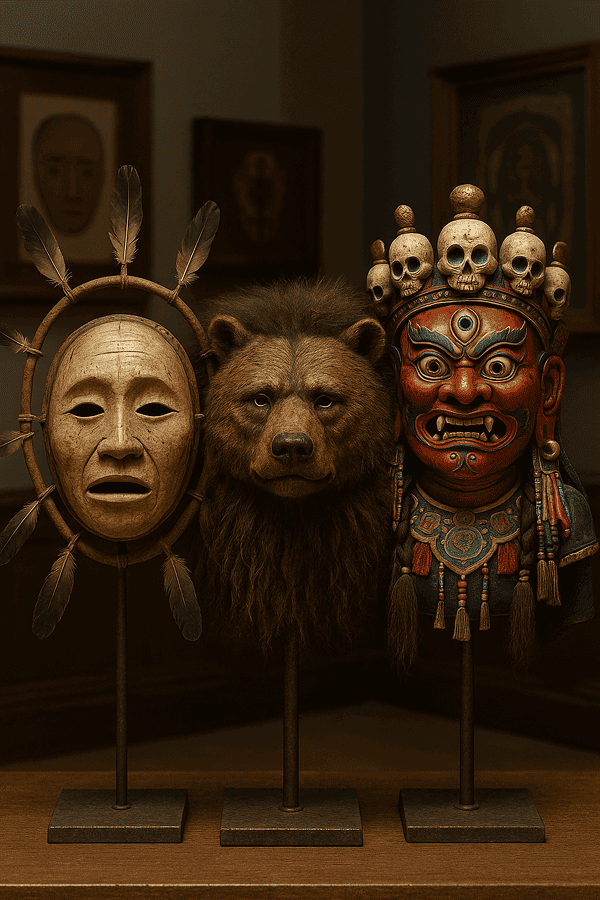Ritual Shamanic Masks are among the most powerful and fascinating artifacts of human spiritual expression. Traditionally used by shamans — spiritual mediators and healers — in diverse cultures from Siberia and Mongolia to the Americas and Oceania, these masks serve as tools for transformation and communication with the spirit world. Visually, shamanic masks often feature exaggerated facial features, animal motifs, feathers, horns, and natural materials such as wood, leather, bone, or metal. Their appearance is both striking and symbolic, designed to evoke awe and to facilitate altered states of consciousness. The tradition of shamanic masking dates back thousands of years, with roots in prehistoric rituals and animistic beliefs, and remains a vibrant part of cultural heritage in many indigenous societies.
Historical Origins of Ritual Shamanic Masks
The origin of ritual shamanic masks can be traced to ancient traditions of animism and ancestor worship. The word “shaman” itself is derived from the Evenki (Tungusic) word “šaman,” meaning “one who knows,” and it is in the icy forests of Siberia that some of the oldest shamanic mask traditions are found. Archaeological evidence from sites in Russia and Central Asia indicates that masks were used in rituals as early as the Neolithic period. Over time, the design and function of shamanic masks evolved in response to social, environmental, and religious changes. In Mongolia, for example, masks became more elaborate as shamanic practices merged with Buddhist influences. Historical records — such as the accounts of explorers like Wilhelm Radloff and the ethnographic collections of museums — attest to the significance of these masks in the life of many Eurasian peoples. Today, ritual shamanic masks continue to evolve, incorporating both traditional and contemporary elements.
Cultural Significance and Symbolism of Shamanic Masks
Ritual shamanic masks hold deep symbolic meaning in their native cultures. They are believed to serve as vehicles for spiritual transformation, allowing the wearer to embody deities, animal spirits, or ancestral souls. In many Siberian traditions, the mask is seen as a “face” for supernatural beings, enabling direct communication with the spirit world during ceremonies. Myths and legends abound regarding the powers of shamanic masks — some are said to grant visions, others to protect communities from malevolent forces. In social terms, the use of masks is closely tied to the role of the shaman as healer, mediator, and keeper of tradition. The performance of masked rituals reinforces communal identity and transmits cultural knowledge across generations.

Materials and Craft Techniques in Shamanic Mask Making
The creation of ritual shamanic masks is an art steeped in tradition and symbolism. Artisans use materials imbued with spiritual significance, such as linden or birch wood, animal hides, bones, teeth, shells, and metals like copper or bronze. The process often begins with ritual preparation, including prayers and offerings to ancestral spirits. Tools range from simple knives and chisels to more specialized implements for carving, painting, and engraving. Decorative elements — such as feathers, beads, fur, and pigments derived from plants or minerals — are chosen for their protective or empowering properties. In some regions, masks are painted with specific colors: red for vitality, white for purity, black for the underworld, each carrying layered meanings. Regional differences are pronounced — for example, Siberian masks may feature bear or reindeer motifs, while Mongolian masks often incorporate Buddhist iconography.
Functions and Uses of Ritual Shamanic Masks
Ritual shamanic masks have a primary function in ceremonial and religious contexts. Shamans wear these masks during rites of healing, initiation, divination, and seasonal festivals, believing they facilitate contact with spirits and ancestors. Theatrical and performative aspects are also central, as masked dances and storytelling are used to transmit myths and moral lessons. In some cultures, shamanic masks play a role in community celebrations, marking important calendrical events or transitions. Over time, the use of these masks has adapted — today, they may appear in cultural festivals, educational settings, or even contemporary art. Yet, their core function as instruments of spiritual transformation endures.
Regional Variations in Shamanic Mask Traditions
Shamanic mask traditions display remarkable diversity across different regions. In Siberia, the Chukchi and Evenki create masks with animalistic features, reflecting their animistic worldview. Mongolian shamans (Böö) use intricately painted wooden or metal masks, sometimes depicting wrathful deities. In the Americas, indigenous peoples such as the Yup’ik of Alaska craft elaborate masks from driftwood and animal sinew, often representing myths about animal-human transformation. Each tradition reflects unique local beliefs, materials, and aesthetics, yet all share the underlying goal of bridging the human and spiritual realms. Comparisons with other ritual masks, such as those from African or Oceanic cultures, reveal both parallels and distinctive features.
Famous Shamanic Masks and Collections
A number of ritual shamanic masks have gained international recognition due to their artistry and historical significance. Notable examples include the Yup’ik dance masks of Alaska, the Siberian bear masks from the Russian Far East, and the Mongolian Tsam masks used in Buddhist-influenced shamanic rituals. These masks can be seen in major museums such as the Smithsonian Institution (Washington, D.C.), the Russian Museum of Ethnography (St. Petersburg), and the National Museum of Mongolia (Ulaanbaatar). Important private collections and exhibitions — many cataloged by expert resources like toddmasks.com — also offer opportunities to appreciate these remarkable artifacts. Archaeological finds, such as ancient wooden masks from Siberian burial sites, provide rare glimpses into the earliest forms of shamanic ritual.

Influence of Ritual Shamanic Masks on Art and Culture
The visual language of shamanic masks has left a lasting impact on art, literature, cinema, and even fashion. Modern artists have drawn inspiration from the bold forms and spiritual symbolism of these masks, as seen in the works of Pablo Picasso and the surrealists. Shamanic motifs appear in novels, films, and music, often as metaphors for transformation and transcendence. Contemporary designers incorporate mask-inspired elements into jewelry, textiles, and stage costumes, bringing ancient traditions into modern aesthetics. The enduring presence of shamanic masks in popular culture highlights their continued relevance and their crucial role in preserving and transmitting cultural heritage.
Contemporary Status and Preservation of Shamanic Mask Traditions
Today, the tradition of ritual shamanic masks faces both challenges and opportunities. While some communities struggle with the pressures of modernization, others actively work to revive and sustain mask-making and ritual practices. Contemporary masters and schools — especially in Siberia, Mongolia, and Alaska — continue to create masks using both traditional and innovative techniques. Preservation efforts include educational programs, workshops, and collaborations with museums and cultural organizations. New generations are learning the craft, ensuring the living continuity of this ancient tradition. Online resources, including toddmasks.com, play a key role in connecting enthusiasts, collectors, and scholars worldwide.
Collecting and Acquiring Ritual Shamanic Masks
The market for ritual shamanic masks is both vibrant and complex. Authentic examples can be found through reputable galleries, auction houses, and directly from artists or indigenous communities. Prices vary widely, influenced by factors such as age, provenance, material, and artistic quality. Collectors are advised to research thoroughly and seek expert guidance — resources like toddmasks.com offer advice on authentication, valuation, and ethical acquisition. It is crucial to respect the cultural origins of these masks and avoid purchasing objects obtained through exploitation or illegal export. Ethical collecting supports artisans and helps safeguard traditions for future generations.
